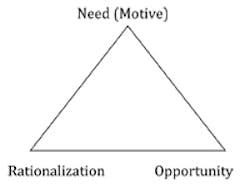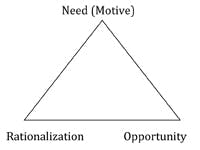Online Exclusive: Accounting Basics for Small Contractors — Employee Fraud
In some of the previous installments of this series, we’ve discussed the importance of proper job costing, the industry’s dismal 3.5% profit percentage before taxes, the difference between profits and the cash in your bank account, and why cash flow is so important to the company. Let’s assume that you have educated yourself on those topics and your business is performing at or above that profit percentage.
What would you say if I told you that, on average, a typical business loses 5% of its revenue each year due to fraud? According to the 2014 Report to the Nations on Occupational Fraud from the Association of Certified Fraud Examiners (ACFE), survey participants estimated that 5% of annual revenues are lost to fraud each year. The Gross Domestic Product (GDP) of the United States in 2013 was $16.8 trillion. That means, in the U.S. in 2013, $840 million was lost to fraud.
Fraud isn’t only a “big business” issue. It isn’t only a retail issue. Small businesses are actually more vulnerable to fraud because of the constraints of their financial and personnel resources. Small businesses (less than 100 employees) incurred a median loss of $154,000.
Take a moment and think about that if you’re a small contractor. Could you sustain a $154,000 loss right now and survive, let alone, grow your business? Many business owners I know couldn’t. That’s why small businesses are less likely to survive an average fraud loss.
Small business owners don’t think they’re at much risk because they trust the employees they have. They tend to place too much trust in their employees. “None of my employees would steal from me.” Wrong. Any employee in any business large or small might resort to stealing if their situation becomes dire enough and there aren’t proper controls in place. As a matter of fact, according to that ACFE report, those employees who earn a higher level of trust have more opportunities to commit a fraud.
What does fraud mean? The ACFE defines occupational fraud as the use of one’s employment for personal gain through the deliberate misuse or misapplication of the organization’s resources. For fraud to develop, there are three conditions that must be present (The “Fraud Triangle”):
- Need
- Opportunity
- Rationalization
Need — There must be a need by the individual(s). There’s got to be a motivation for them to commit the act. A non-sharable financial pressure might be a spouse losing his job, a reduction in wages or benefits (like health care) or increased medical expenses. The employee could have a drug, alcohol or gambling problem or could be dissatisfied with his job.
Rationalization — The individual has to justify her fraudulent actions. She needs to have an excuse for committing fraud. With the current state of the economy, employees are finding more excuses. Do any of these excuses sound familiar?
- I’m worth more than they’re paying me.
- I’m doing twice the amount of work since they cut staff.
- I need more money to pay my bills.
- Others are stealing so why can’t I as well.
- They’re making plenty of money. They won’t miss this much.
- I’m just borrowing the money. It’s a loan. I’ll pay it back.
The third component needed for fraud to occur is the only one that the company has control over. That one is…
Opportunity — There has to be an opportunity for the fraud to be committed. They have to believe that they won’t be detected or caught perpetrating the fraud. Some examples of opportunities could be not reviewing employee time cards, not securing access to cash and company checks or not monitoring company fuel purchases.
The third component for fraud to occur is the only one the company has control over.—Mike Bohinc
You need all three angles of the fraud triangle in place to have occupational fraud.
Some “red flags” to watch out for with your employees:
- Living beyond their means
- Financial difficulties
- “Too close” relationship with a vendor or client
- Irritability, suspiciousness, or defensiveness
- Family problems (like divorce or child custody)
- Control issues — unwilling to share duties or take vacations
While you can never completely eliminate the possibility of fraud, there are things that can be done to minimize the chances of it occurring. In the next installment, I’ll define internal controls and how you can implement them in your company to reduce the chances that you’ll be a victim of fraud.
Michael Bohinc is a Certified Public Accountant in Cleveland, Ohio, and the owner of Keeping Score Inc. He has served as the Chief Financial Officer of Norhio Plumbing Inc., his family’s plumbing company in Aurora, Ohio, since 1988. He also currently serves as the Interim Director for the Service Nation Alliance – Plumbing Group. You may contact him via e-mail at [email protected].
About the Author
Michael Bohinc
CPA and CFO
Michael Bohinc is a Certified Public Accountant in Cleveland, Ohio, and the owner of Keeping Score Inc. He has served as the Chief Financial Officer of Norhio Plumbing Inc., his family’s plumbing company in Aurora, Ohio, since 1988. A veteran speaker, he's trained hundreds of contractors in the basics of accounting and on fraud prevention. He also currently serves as the Interim Director for the Service Nation Alliance – Plumbing Group. He's also a die-hard Cleveland Indians fan. You may contact him via e-mail at [email protected].

